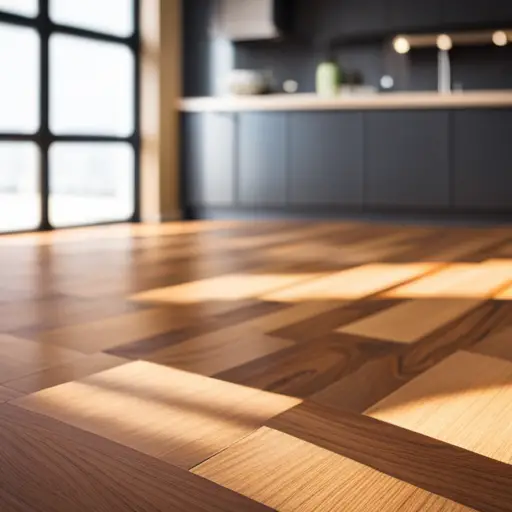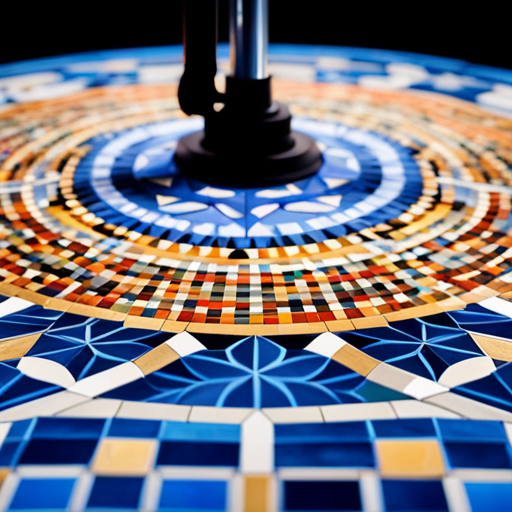Transitioning Flooring Between Rooms

As we walk through the spaces of our homes, the transition between different types of flooring can often serve as a seamless link, or an abrupt interruption.
In the art of interior design, mastering the graceful flow between rooms is a skill that demands both practical understanding and creative finesse.
From selecting the right thresholds to incorporating design elements, this article explores the intricate dance of transitioning flooring between rooms, offering practical solutions and creative insights for achieving a harmonious and visually captivating result.
Understanding Transition Strips
Understanding transition strips is essential when transitioning flooring between rooms, as they serve to provide a smooth and visually appealing boundary between different types of flooring.
When it comes to threshold installation, proper selection and installation of transition strips are vital for creating seamless flooring junctions. There are various transition techniques and transition strip selections available to ensure that flooring connections are not only structurally sound but also aesthetically pleasing.
For instance, when dealing with uneven floors, choosing the right transition strip can provide elegant solutions to ensure a level and polished appearance. By understanding the nuances of transition strips, it becomes possible to address potential challenges such as uneven floor solutions and to create a harmonious flow between different types of flooring within a space.
Now, let’s delve into the importance of choosing the right thresholds to ensure a flawless and cohesive transition between floorings.
Choosing the Right Thresholds
When transitioning flooring between rooms, selecting the appropriate thresholds is crucial for ensuring a seamless and visually appealing connection between different types of flooring. The right threshold not only provides a smooth transition but also enhances the overall aesthetic of the space.
Here are some essential considerations for choosing the right thresholds:
-
Threshold Options: Explore various threshold styles such as T-molding, flush thresholds, or overlap reducers to find the best fit for your specific flooring types and room layouts.
-
Transition Strip Materials: Consider materials like wood, metal, or laminate for transition strips to complement the flooring materials and ensure durability and longevity.
-
Blending Styles, Pattern, and Color Choices: Harmonize the threshold with the existing decor by selecting a style, pattern, and color that complements both flooring types, creating a cohesive and unified look.
Careful selection of threshold options, transition strip materials, and attention to blending styles, patterns, and color choices will result in a smooth, visually pleasing transition between rooms, elevating the overall design and functionality of the space.
Blending Different Flooring Types
When transitioning between different flooring types, it’s important to consider various flooring transition tips to ensure a seamless connection between rooms.
Blending different flooring types allows for creative design opportunities, enabling the use of multiple materials to achieve a cohesive and visually appealing look.
Flooring Transition Tips
How can different types of flooring be seamlessly blended to create a cohesive transition between rooms? Achieving a harmonious flooring transition involves careful consideration of flooring color schemes and decorative transition options. Here are some tips to help blend different flooring types effectively:
-
Gradual Transition: Utilize a gradual transition by incorporating a narrow, decorative strip that gradually merges the two flooring types, creating a smooth and visually appealing shift.
-
Threshold Molding: Consider using threshold molding, which provides a clean and polished transition between different flooring materials while also serving as an elegant design element.
-
Complementary Colors: Opt for complementary colors or shades when selecting different flooring types to ensure a seamless and unified transition, enhancing the overall aesthetic appeal of the space.
Seamless Room Connections
To ensure seamless room connections and a cohesive transition between different flooring types, it is essential to carefully consider the use of a common noun and its visual impact on the overall space. Room flow and transition techniques play a crucial role in creating a harmonious transition between different flooring materials. By strategically blending distinct flooring types, you can achieve a smooth and visually appealing connection between rooms. One effective way to achieve this is by using transition pieces that complement both flooring materials. Below is a table summarizing key transition techniques to create a seamless room connection:
| Transition Technique | Description | Visual Impact |
|---|---|---|
| Threshold | Creates a clean break | Smooth transition |
| Border | Defines the separation | Subtle contrast |
| Inlay | Integrates both floors | Unique focal point |
Designing With Multiple Materials
Designing with multiple materials and blending different flooring types is a critical aspect of achieving a harmonious transition between rooms, building upon the techniques previously discussed. When incorporating material contrast, consider using hardwood in one room and tiles in another to create a striking visual difference.
To ensure flow continuity, opt for flooring materials with complementary colors or textures, allowing for a seamless transition while maintaining a sense of cohesion. Additionally, consider using area rugs or floor borders to delineate the different flooring types and create a smooth visual transition.
By skillfully blending different flooring types, a sense of unity and distinction can be achieved within the home.
Now, let’s delve into the next section about incorporating creative design elements.
Incorporating Creative Design Elements
Incorporating creative design elements into the transition between flooring in different rooms requires careful coordination and thoughtful consideration of aesthetic cohesion. One way to achieve this is by combining different materials in a visually appealing manner. The table below illustrates some inspiring ideas for incorporating decorative elements and flooring transition inspiration:
| Creative Design Element | Description |
|---|---|
| Mosaic Borders | Introducing a mosaic border along the transition line can seamlessly merge two different flooring materials, adding a touch of elegance. |
| Wood Medallions | Incorporating wood medallions can create a stunning focal point at the transition, providing a smooth visual flow between rooms. |
| Patterned Tiles | Using patterned tiles in the transition zone can add a unique and artistic flair, effectively tying the two distinct flooring types together. |
| Inlays and Borders | Intricate inlays and borders can be employed to define the transition area, offering a sophisticated and seamless connection between different floorings. |
Seamless Transitions With Pattern and Color
Achieving seamless transitions between flooring in different rooms can be accomplished through the strategic use of pattern and color coordination. When aiming for a cohesive flow, consider these important factors:
-
Color Coordination: Selecting flooring materials with complementary or harmonizing colors can create a unified visual appeal. For instance, if one room features a warm, honey-toned wood floor, transitioning into a room with a similarly warm-toned tile can create a seamless connection.
-
Pattern Continuity: Maintaining a consistent pattern or motif across rooms can also facilitate a smooth transition. Whether it’s through the use of geometric shapes, herringbone patterns, or intricate designs, carrying a consistent pattern from one room to the next can tie the spaces together.
-
Accent Pieces: Introducing accent elements such as area rugs or borders can serve as a bridge between different flooring materials. By incorporating rugs with colors and patterns that echo those of the adjacent flooring, you can create a harmonious transition while adding visual interest.
By carefully considering color coordination and pattern continuity, you can achieve a seamless transition between different flooring materials, enhancing the overall aesthetic of your home.
Now, let’s delve into practical solutions for uneven flooring.
Practical Solutions for Uneven Flooring
When it comes to addressing uneven flooring, there are various practical solutions to consider.
From utilizing floor transition options to employing leveling techniques, there are effective ways to achieve a seamless flooring transition.
Floor Transition Options
When dealing with uneven flooring, it is important to consider practical solutions for floor transitions between rooms. This is particularly crucial when addressing flooring border options and transition challenges.
To ensure a seamless room flow and visually appealing material combination, consider the following floor transition options:
-
Threshold Strips: Utilize metal or wooden threshold strips to bridge the height gap between different floorings, providing a smooth and safe transition.
-
T-Molding: This option is effective for transitioning between two hard surfaces of equal height, such as tile to hardwood, creating a clean and visually appealing division between the rooms.
-
Reducing Strips: Ideal for transitioning from a higher to a lower flooring, reducing strips provide a gentle slope to minimize any tripping hazards.
These floor transition options offer practical and aesthetically pleasing solutions for uneven flooring challenges.
Leveling Techniques for Floors
Practically, addressing uneven flooring requires frequent assessments and the implementation of effective leveling techniques to ensure a smooth and safe transition between rooms. Leveling techniques such as self-leveling compounds, floor grinding, or shimming can be employed to achieve floor height consistency.
Self-leveling compounds are ideal for minor irregularities, while floor grinding can rectify more substantial variations. Shimming, on the other hand, involves placing thin, tapered strips of material to even out the flooring. Prior to selecting a method, it is crucial to accurately measure the extent of the unevenness.
Additionally, employing a straightedge or laser level to identify low spots is essential for a successful leveling process. By addressing uneven flooring effectively, the subsequent installation of seamless flooring solutions can proceed with confidence and precision.
Seamless Flooring Solutions
To address uneven flooring effectively and ensure a smooth transition between rooms, practical seamless flooring solutions are essential. Achieving seamless transitions and flooring continuity can be accomplished through the following methods:
-
Self-leveling underlayment: This technique helps to create a uniform surface by filling in low spots and irregularities, providing a smooth base for the new flooring.
-
Transition strips: These strips are designed to create a seamless transition between different types of flooring, such as carpet to hardwood or tile to laminate, ensuring a cohesive look throughout the space.
-
Flexible floor adhesive: Using a flexible adhesive can help compensate for minor level differences, allowing the flooring to adjust and adhere evenly to the subfloor, resulting in a seamless and consistent finish.
Maintaining Consistency in Floor Height
Achieving a consistent floor height is essential for creating a seamless transition between different types of flooring in adjoining rooms. Floor levelness and consistency are not only crucial for aesthetics but also for functionality.
Inconsistent floor heights can pose tripping hazards and create an unpleasant visual break in the space. To maintain consistency in floor height when transitioning between different types of flooring, careful planning and precise installation are necessary.
One effective method is to use transition strips or moldings that not only bridge the gap between different flooring materials but also ensure an even transition in floor height. Additionally, subfloor leveling techniques can be employed to address any discrepancies in height between the adjoining rooms.
It is important to consider the thickness of each type of flooring material and factor this into the transition process to ensure a smooth and level transition. By paying attention to these details, it is possible to achieve a seamless and visually appealing transition between different flooring materials while maintaining consistency in floor height.
Frequently Asked Questions
How Can I Ensure a Smooth Transition Between Different Flooring Materials in Terms of Height and Texture?
To ensure a smooth transition between different flooring materials in terms of height and texture, it is essential to focus on color coordination and material blending. This will facilitate seamless integration and create visual flow between the rooms.
What Are Some Creative Design Options for Transitioning Between Rooms With Different Flooring?
When considering transitioning between rooms with different flooring, creative design options can enhance visual flow and pattern continuity. Utilize color contrast for impact, and material blending for cohesion, ensuring a seamless transition between spaces.
Are There Any Special Considerations for Transitioning Flooring in Rooms With Uneven Floors?
When dealing with uneven floors, it’s crucial to address flooring leveling to ensure a seamless transition. Floor transition strips can be used to bridge gaps and provide a smooth, safe shift between different floor types, enhancing both aesthetics and functionality.
How Can I Maintain a Consistent Floor Height Throughout My Home When Transitioning Between Rooms?
Maintaining a consistent floor height throughout your home when transitioning between rooms is akin to seamlessly blending colors in a painting. Achieve this by employing effective floor leveling techniques and thoughtfully designed thresholds for a harmonious transition.
What Are Some Practical Solutions for Transitioning Between Rooms With Vastly Different Flooring Materials?
When transitioning between rooms with vastly different flooring materials, practical solutions can enhance visual appeal and functionality. Incorporating color coordination, functional thresholds, and seamless integration can create a cohesive and aesthetically pleasing transition.
Conclusion
In conclusion, transitioning flooring between rooms requires careful consideration and planning to ensure a seamless and cohesive look.
By understanding transition strips, choosing the right thresholds, blending different flooring types, and incorporating creative design elements, you can achieve a visually appealing and functional transition.
Remember, ‘a stitch in time saves nine,’ so take the time to carefully plan and execute your flooring transition for long-lasting satisfaction.

Rubin Everest, a seasoned expert in the world of flooring, brings a wealth of knowledge and passion to the surface. As the mind behind ebbow.com, Rubin is dedicated to sharing insights on the latest trends, innovative solutions, and expert advice in the realm of flooring. Whether you’re seeking practical tips for installation or design inspiration, Rubin Everest is your go-to source for all things flooring-related, making your journey to the perfect floor an informed and enjoyable experience.





